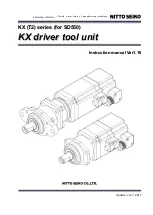
ODC001 Servo Motor Driver
2.5.4
APT Server (ActiveX Controls)
ActiveX Controls are re-usable compiled software components that supply both a
graphical user interface and a programmable interface. Many such Controls are
available for Windows applications development, providing a large range of re-usable
functionality. For example, there are Controls available that can be used to
manipulate image files, connect to the internet or simply provide user interface
components such as buttons and list boxes.
With the APT system, ActiveX Controls are deployed to allow direct control over (and
also reflect the status of) the range of electronic controller units, including the
OptoDCDriver. Software applications that use ActiveX Controls are often referred to
as ’client applications’. Based on ActiveX interfacing technology, an ActiveX Control
is a language independent software component. Consequently ActiveX Controls can
be incorporated into a wide range of software development environments for use by
client application developers. Development environments supported include Visual
Basic, Labview, Visual C++, C++ Builder, HPVEE, Matlab, VB.NET, C#.NET and, via
VBA, Microsoft Office applications such as Excel and Word.
Consider the ActiveX Control supplied for the APT OptoDC servo driver unit.
This Control provides a complete user graphical instrument panel to allow the motor
unit to be manually operated, as well as a complete set of software functions (often
called methods) to allow all parameters to be set and motor operations to be
automated by a client application. The instrument panel reflects the current operating
state of the controller unit to which it is associated (e.g. such as motor position).
Updates to the panel take place automatically when a user (client) application is
making software calls into the same Control. For example, if a client application
instructs the associated DC servo motor Control to move a motor, the progress of that
move is reflected automatically by changing position readouts on the graphical
interface, without the need for further programming intervention.
















































